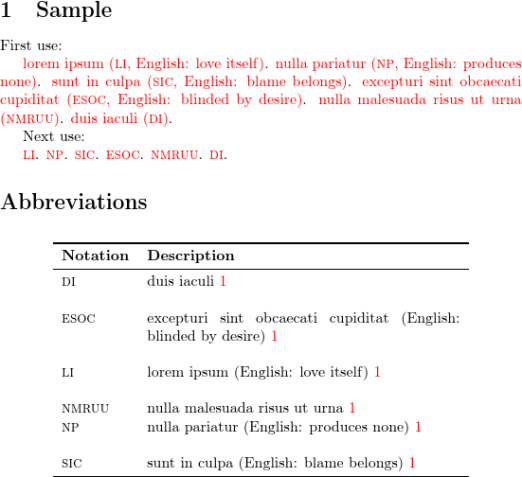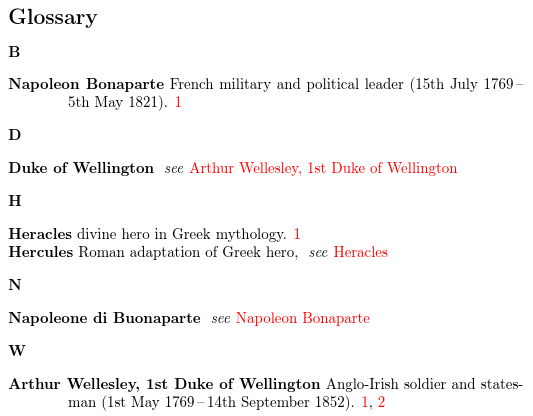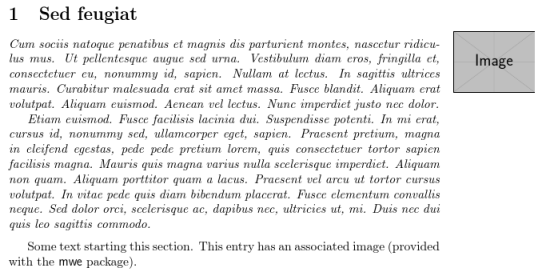Gallery
A selection of images or sample documents related to my books or packages or to code I have helped develop. For some great examples of images created using LaTeX, have a look at the TikZ and PGF gallery on texample.net, or for some examples of what can be done with TeX have a look at The TeX showcase.
The purpose of LaTeX-related sections of the gallery is to illustrate various styles that can be created with the particular package. If you want to know how to do something not illustrated here or you want to know how to adapt one of these examples, please post your query to an appropriate site such as TeX on StackExchange or The LaTeX Community Forum.
Click on the images below for details. If you would like to know whenever a new item is added to the gallery, you can subscribe to the news RSS feed or login and use the Account page to subscribe to news notifications for the “gallery” tag.
If you have a small screen, you may prefer to switch on the small image setting.
Search
File List
View alphabetical list of all .tex and .bib files used in the examples that are available for download.
glossaries
These are some sample documents that use the glossaries package. Most of these examples use dummy lorum ipsum text, one of them uses the sample image files provided by the mwe package, which is available on both MiKTeX and TeX Live, and one of them uses the sample bibliography file xampl.bib, which should be readily available in your TeX distribution. Make sure you have an up-to-date version of the glossaries package if you want to try any of these examples. For help with building the glossary see Incorporating makeglossaries or makeglossaries-lite or bib2gls into the document build.
glossaries-extra
The glossaries-extra package is an extension to the glossaries package. It provides better abbreviation handling and extra features, as demonstrated by these examples. For help with building the glossary see Incorporating makeglossaries or makeglossaries-lite or bib2gls into the document build.
Initialisms
The dots in the abbreviations in this example are automatically inserted through the use of category attributes. The sentence terminator following commands like \gls can be automatically discarded for those entries.
Abbreviations With Translations
An alternative to the base glossaries example this example uses the more convenient glossaries-extra settings.
Mixed Glossary with Emphasis (glossaries-extra.sty)
This is an alternative to the similar example with just the base package.
Mixing Styles
This rather colourful example isn’t encouraging garish documents, but is illustrating how you can apply different styles to entries according to their category and category attributes. With just the basic glossaries.sty package, different styles may only be applied per glossary type, whereas in this example all entries are in the same glossary.
Adjusting Parenthetical Style
This example adjusts the user parenthetical style so that only the long form is displayed on first use and the short form on subsequent use. Both the long and short form are emphasized. With the introduction of the long-only-short-only style, that may now be used as an alternative.
Abbreviations with Footnotes Sample
This example compares the footnote and postfootnote styles (using the small-caps variant).
Adjusting the alttree Style
The alttree style is redefined by the glossaries-extra-stylemods package to make it more flexible. This example uses the commands provided by this package to adjust the style. The location list and associated image are placed in the right margin and the entry name is on the left.
Abbreviation Styles
This example demonstrates some of the predefined abbreviation styles.
Aliases
This example demonstrates the use of the alias key.
Units (glossaries-extra.sty)
This example demonstrates the use of the category key in combination with the post-link hook to append the entry’s symbol in the text on first use. This is an alternative to using the abbreviation mechanism.
Standalone Entries
Instead of displaying a sorted list, this example uses standalone entries. Since no sorting or indexing is required, the build process is quite simple.
Mini-Glossary
This example provides an environment that displays a mini list of terms at the end of it. This is in addition to the main glossary at the end of the document. There’s a similar example for bib2gls.
bib2gls
With the base glossaries package you can sort and collate using makeindex or xindy or using TeX. (See the glossaries performance page for a comparison.)
The glossaries-extra package additionally provides a way of simply listing all defined entries in the order of definition without the need for an external tool, but it also provides another sorting and collation method and that’s with bib2gls. Some of the examples below can be found in bib2gls’s examples directory and are described in more detail in the “Examples” chapter of the bib2gls user manual. For help with building the glossary see Incorporating makeglossaries or makeglossaries-lite or bib2gls into the document build.
Performance
arara
Paulo Cereda’s cool automation tool arara has been upgraded to version 4.0 and with it comes some new localisation! Here are some screenshots. (That’s Broad Norfolk, in case you’re confused.)
Book Launch Photos
Photos from book launches.












